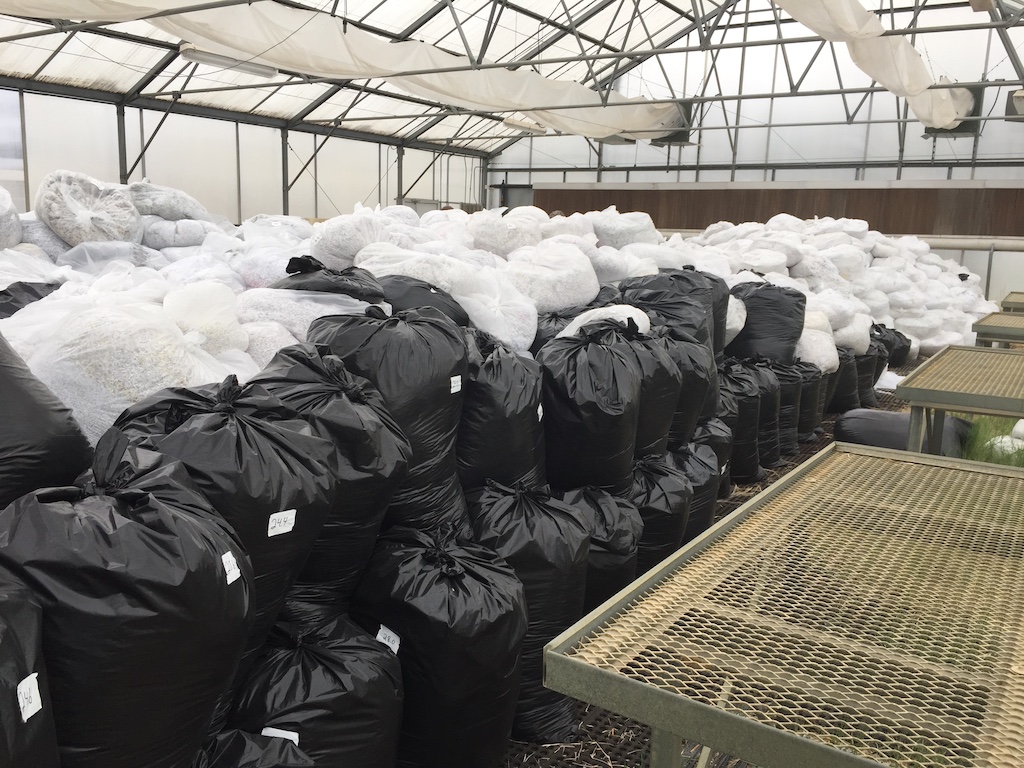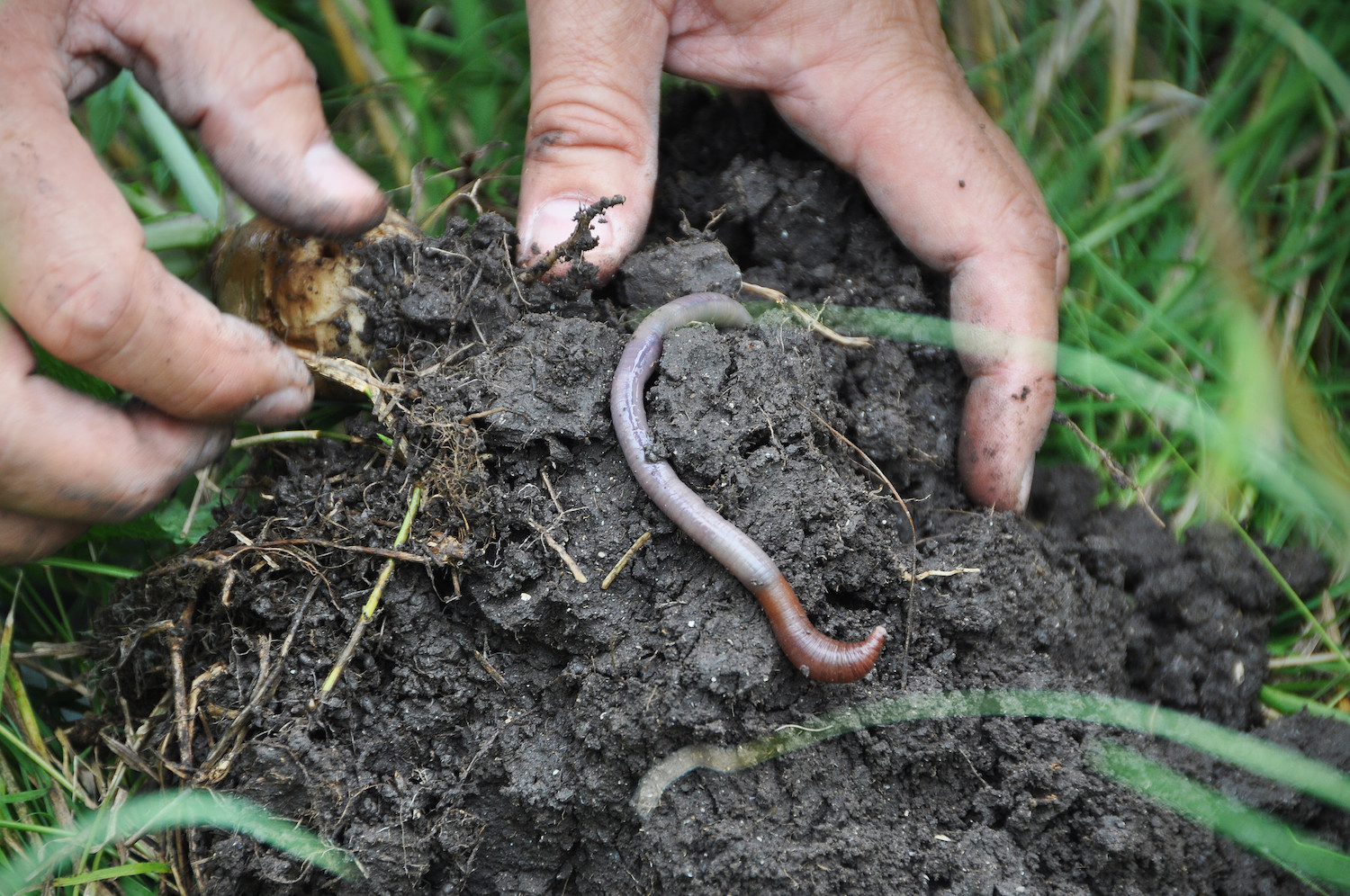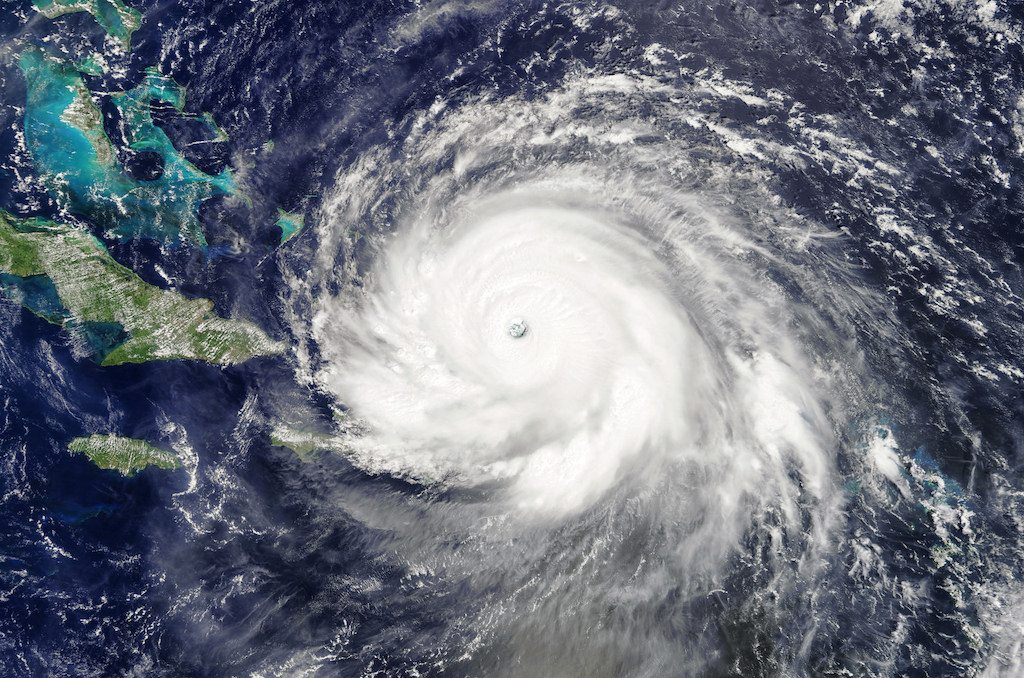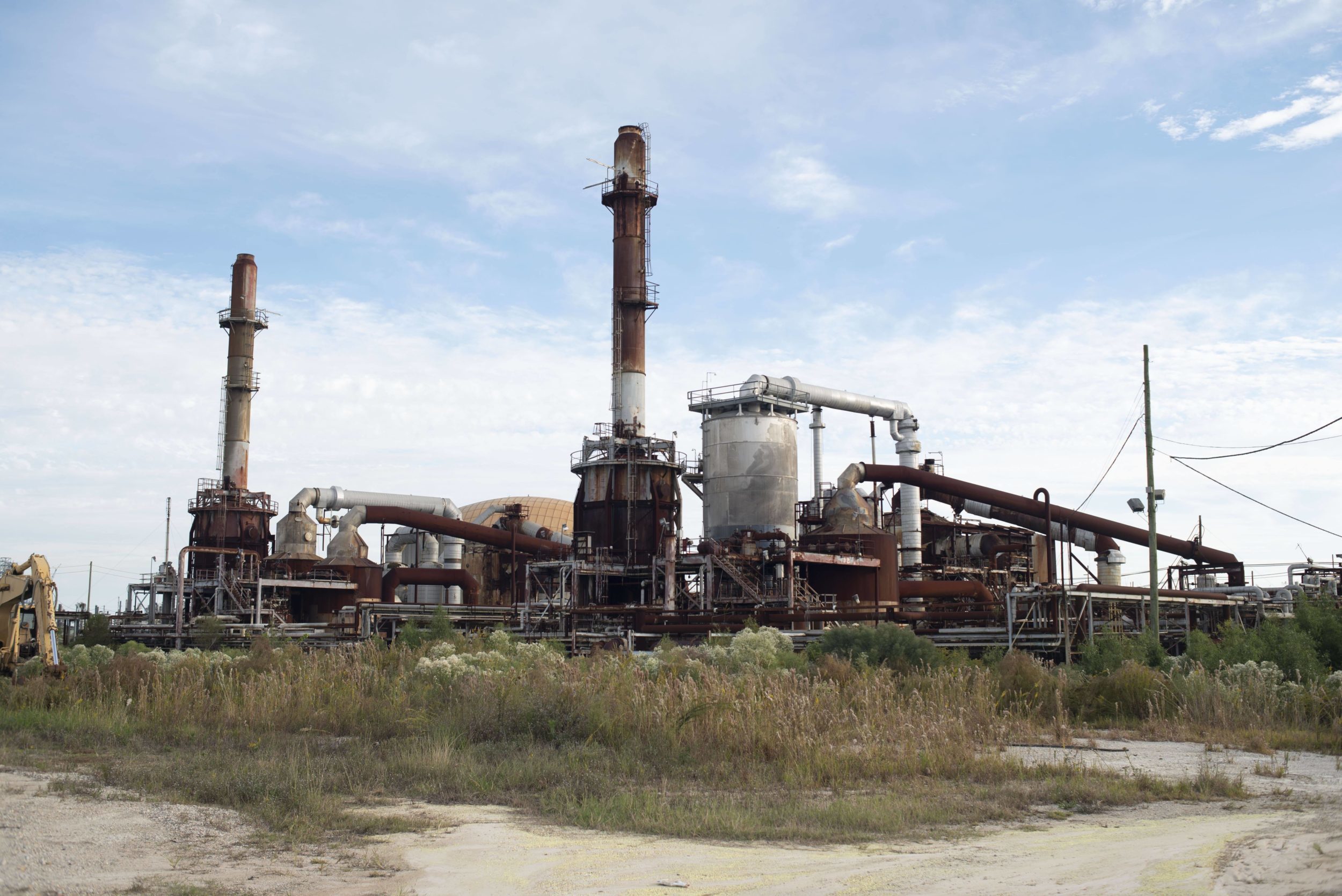
Boyce Upholt
Phosphate rock allowed farmers to stop using manure fertilizer, kicking us into the modern era of agriculture. But those who live near the mining industry’s epicenter fear its huge towers of radioactive sludge will pour into their backyards.
Late in 2018, a farmer in St. James Parish, Louisiana, began the final harvest of the sugarcane season. The green stalks, once cleared, revealed an unexpected topography: a small hill, four or five feet high, amid ground that had always lain flat.
Above: An abandoned plant in Pascagoula, Mississippi, formerly run by the the Mississippi Phosphates Corporation, once processed strip-mined phosphate rock into powerful fertilizer
The farmland in question sits just north of a far larger—and far more ominous—landmark. “Gypsum Stack No. 4” is tall enough to be noted on federal aviation maps. From the ground, the mound is visible from a distance of three miles: a wall of fine white sand, over 200 feet high, in a parish where the natural elevation never cracks 30 feet. The stack is the largest in a set of piles that, together, cover 975 acres, more ground than Manhattan’s Central Park. It’s built from phosphogypsum, a mildly radioactive waste byproduct issued from a nearby phosphorus fertilizer plant.
The farmer’s sugar could not exist without phosphorus. No life can: this element is an essential component of DNA, and cellular materials can’t grow without a steady supply of it. The Mosaic Company, the owners of Stack No. 4, calls itself “the largest producer of finished concentrated phosphates in the world.” The company’s mission is “to help the world grow the food it needs,” which it accomplishes by strip-mining phosphate rock and acid-blasting it into a form of phosphorus easy for plants to absorb.
It’s a process that produces plenty of wealth: The “marketable product” produced by U.S. phosphate mines was valued at $1.8 billion in 2018. It also results in plenty of waste. Much of the processed rock is piled into “gypstacks” like the pile in St. James Parish, which typically double as storage for wastewater. After absorbing the metals and chemicals contained within the phosphogypsum, that water becomes both acidic and radioactive; when it’s been allowed to leak into waterways, this slurry has been known to cause fish kills. At the end of 2018, when the sugarcane farmer in St. James Parish discovered the bulging field, Gypsum Stack No. 4 held more than 700 million gallons of this sludge.
Mosaic’s engineers quickly confirmed the source of the uplift: a part of Stack No. 4’s north wall was, under the weight of that wastewater, bowing outwards, putting pressure on the adjoining soil. The wall, shifting at a rate of as much as a half inch per day, had already moved 13 feet, a longstanding problem that had escaped notice. Suddenly, emergency action was necessary. Without pumping out some water, constructing a new berm, or plugging culverts beneath a nearby highway, the pile might leak or even burst, unleashing the toxic slurry into the surrounding network of bayous.
The “marketable product” produced by U.S. phosphate mines was valued at $1.8 billion in 2018. It also results in plenty of waste.
At the risk of being too heavy handed, I have to say this strikes me as a metaphor for the entire system—the entire modern landscape of farming—that we’ve built.
—
School children, when they learn about the magic of photosynthesis, are told that plants eat sunlight and carbon dioxide and poop out oxygen. That’s a pretty picture, but it’s incomplete: for a full and balanced diet, plants need many other minerals and nutrients. The most important are known by the acronym NPK, which refers to the chemical symbols of nitrogen, phosphorous and potassium, in that order. The first two typically serve as the limiting factors in terrestrial ecosystems. But whereas nitrogen can be pulled from the air in near-limitless quantities, phosphorous is earthbound, a relative rarity. Isaac Asimov once referred to it as “life’s bottleneck.”
In a natural ecosystem, phosphorus, along with other nutrients, is recycled. When a plant or animal dies and decays, the phosphorus in its cells returns to the soil, where it can be absorbed by a new generation of plants. Early agriculturalists learned to conserve nutrients by collecting manure and bird dung and other animal wastes. “It was like a closed loop until barely a hundred years ago,” says Dan Egan, a journalist who is working on a book about the element. “Things died and decayed and were absorbed and grew and died and decayed. And then we kind of turned it into a straight line.”

A phosphogypsum stack located near Fort Meade, Florida
Harvey Henkelmann
As the human population expanded, food production had to keep pace. At first, farmers stuck with biotic phosphorous; guano, excavated from far-flung islands, became an international commodity in the mid-nineteenth century. Around the same time, scientists discovered that phosphate rock—which almost always includes ancient organic matter, compressed over centuries—was a suitable source of fertilizer, too. So, as guano ran short, we began to carve up the earth. Some academics have proposed this shift as a potential starting point of the Anthropocene.
Today, nearly all the food consumed by Americans begins on farms where the soil is treated with commercially produced fertilizers. The soil on these farms is something of an empty shell—a container for plants that must be supplemented with the necessities of life. Our food, then, depends on refineries and mined rocks, making us all, as the Center for Land Use Interpretation has pointed out, geophagists: “people who eat the earth.”
I live in Louisiana and occasionally drive past Stack No. 4. Approaching on the highway, its bulk dominates the horizon, rising up like something out of a fantastical epic—the entrance to Mordor, or the armed wall from Game of Thrones. I initially set out to report on the stack and its potential for disaster. But I quickly found that this was just one bit of the hinterland’s hinterlands, one small parcel within the dispersed and industrialized landscape of the American farm. In an era where we are so concerned with the genealogy of our foodstuffs—who farmed it and where and how—it seemed important to trace this path, too: the story of P.
Which is how I found myself driving through Florida’s Bone Valley, a region that, an hour inland from Tampa, is little visited by tourists. Those who do come tend to be seeking fossils. On the Peace River, paddlers often dredge up ancient sharks’ teeth. The Phosphate Museum in Mulberry, Florida, includes a far more diverse collection: tubeworms that passed away millions of years ago, skulls of an African elephant and the once-common sea cow. All of these, I was told by the docent, were uncovered through the process of phosphate mining.
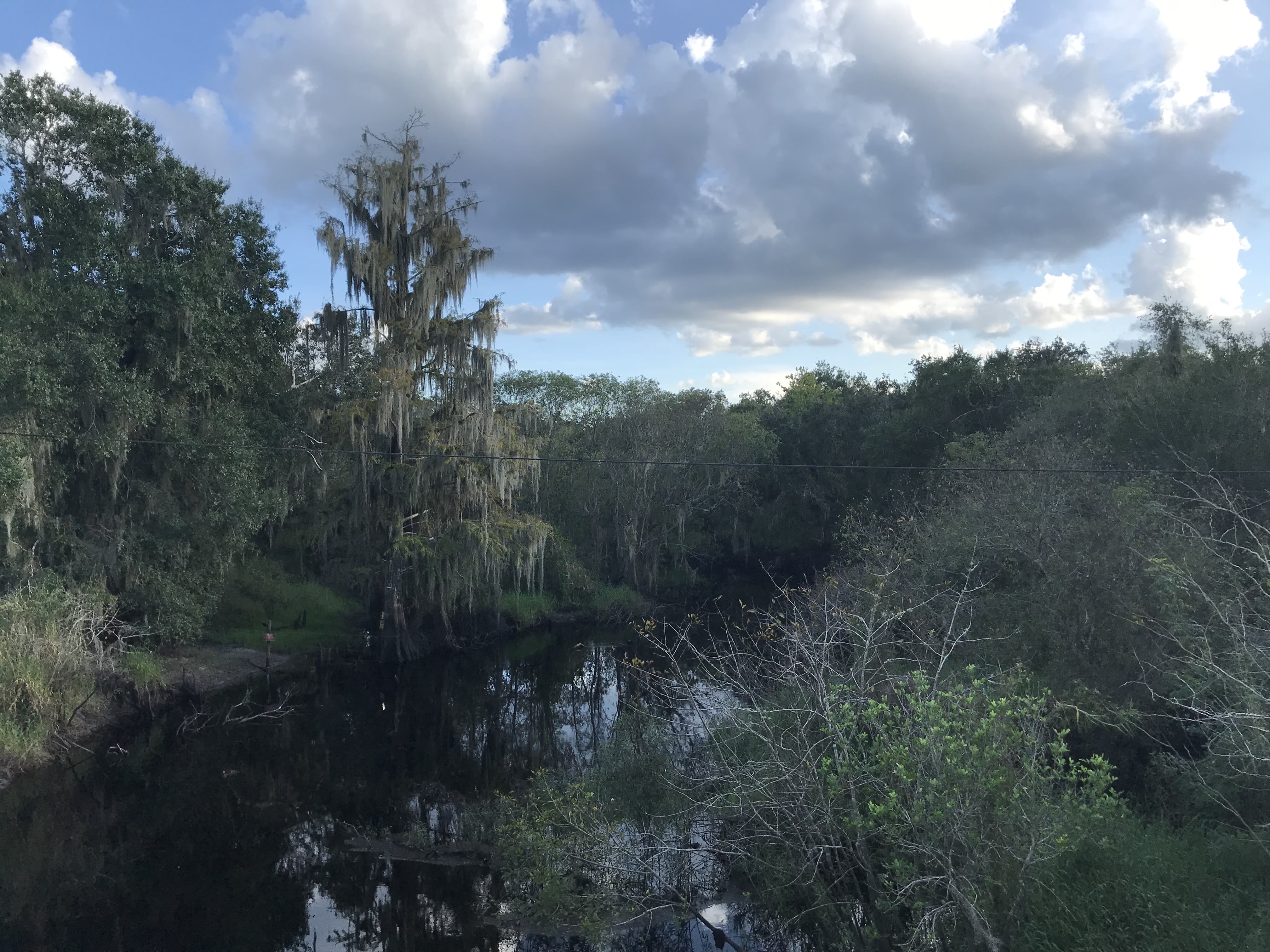
Southwestern Florida’s Peace River is a popular destination for fossil hunters—and part of a region with rich reserves of phosphate rock
Boyce Upholt
Both the phosphate and the fossils are the product of the local geology. The Bone Valley has always been a muddy place, threaded with rivers and estuaries, covered occasionally by rising seas. These sediments helped lock organic materials into the ground, creating one of the nation’s richest reserves of phosphate, a sedimentary rock that contains high levels of phosphorous. (There are also active U.S. phosphate mines in North Carolina, Idaho, and Utah.) In 1881, a surveyor traveling the Peace River noted its phosphate pebbles.
Bone Valley was rugged territory then. Creeks and wetlands threaded through upland forests of oak and pine, where hunters and trappers set up camps, and cattle drivers set cows loose amid the palmetto groves. Before the century was out, a boom town called Mulberry had blossomed to serve the new rush of mining companies. By 1920, Bone Valley provided 90 percent of the world’s supply of phosphate, and it remains the largest source in the U.S. today.
The museum in Mulberry—a bucolic town of 4,000 that has no Main Street but does have a Phosphate Boulevard—is tax-payer funded, though it receives a small annual grant from Mosaic. The overview of the mining process is useful, if cheery. The draglines—the largest earth-moving equipment in the world, according to Mosaic, with buckets the size of a small bedroom—remove the “overburden,” the top layer of soil, to reach the phosphate matrix that sits 30 or so feet below. This matrix is moved into a pit, doused with water, and then piped as slurry to a “beneficiation plant.” There, through various steps, phosphate rock is separated from water and sand and clay. The muddy clay that is pulled out of the phosphate matrix is pumped into “settling ponds,” where the water can slowly rise to the top, to be siphoned away and used again. After a few years, the settling ponds—which occupy roughly half of mined properties—are hardened over, though beneath the upper crust the soil can remain the consistency of oatmeal.
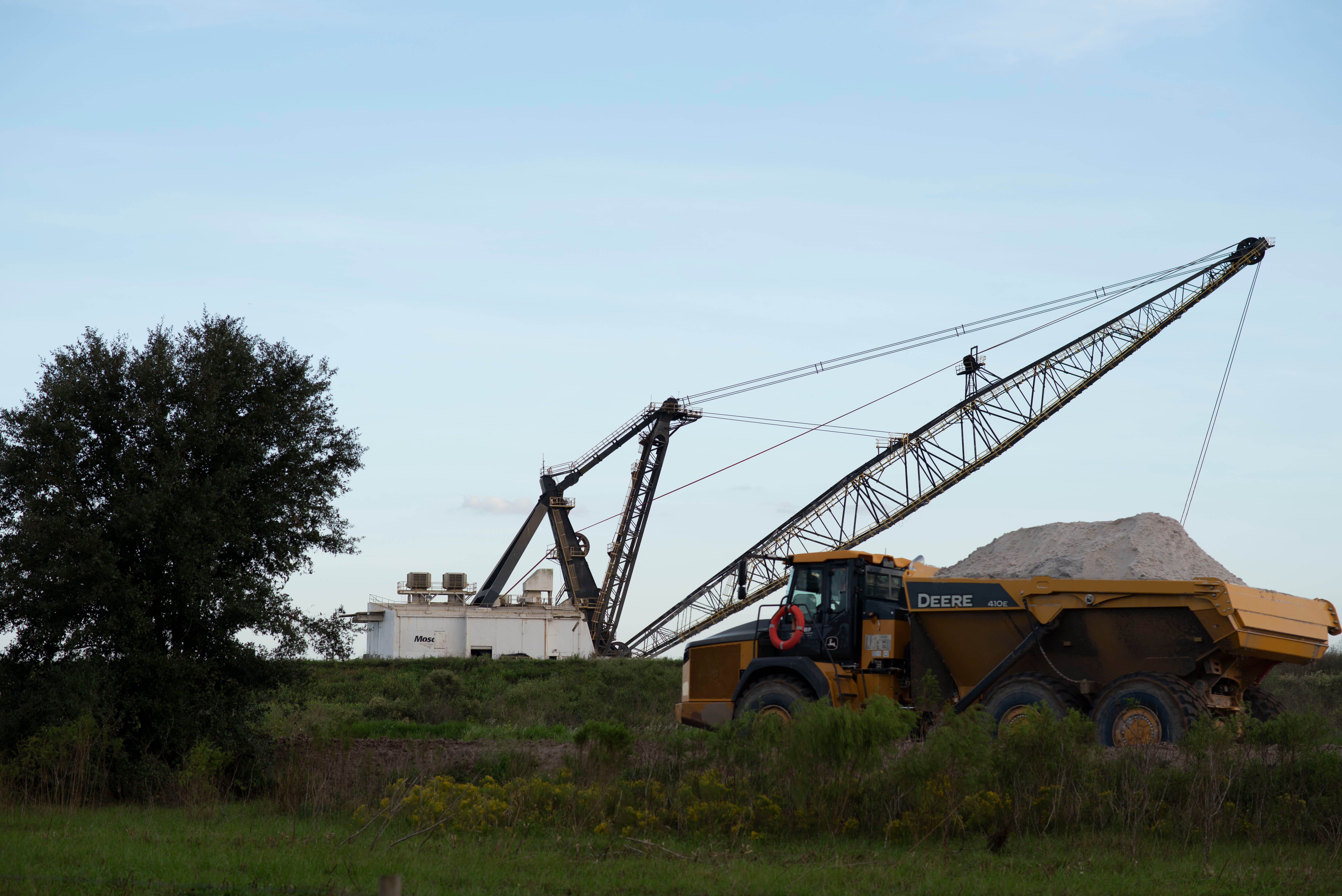
A dragline excavator seen in The Bone Valley region of central Florida
Boyce Upholt
Scattered villages across Polk County—homes and post offices, schools and swimming pools, shops and doctor’s offices—were built by the mining companies to serve their workers in the early 1900s. Within decades, though, amid declining reserves and economic challenges, many were abandoned, sometimes overnight. They are not even ghost towns now: I drove through at least two, and realized it only when I later consulted maps. Besides the occasional bit of concrete, nothing remains but grass and shrubbery. What you really notice driving through mining country are the earthen berms that surround dead mines—raised fortifications sixty feet high, built to trap the water released by the draglines. Look over the lip and you’ll see an alien landscape: the once-flat earth torn into a craggy moonscape of pit and canyons, lined with long linear ponds. The water, stained with algae, takes on unworldly shades of blue and green.
Even critics of mining admit that there is a strange beauty to these landforms: Dennis Mader, the executive director of People for Protecting Peace River, a grassroots environmental group, used to camp out with friends in abandoned mines. “It was like No Man’s Land,” he told Sarasota Magazine. Mosaic owns a luxury golf resort built atop an old mine just south of Mulberry, which treats the man-made pools and hills as an appealing amenity. The first tee stands atop a hundred-foot dune, a relic from the mining; the restaurant inside the modernist lodge is called P2O5, the chemical formula for a common phosphorus compound. The resort opened in 2014, the same year the last mine in Polk County shuttered.
—
“Over 700 square miles of Florida are lost to this industry,” Rachael Curran, an attorney for the Center for Biological Diversity, told me over dinner in Polk County. “That’s half the size of Rhode Island, in the middle of Florida—just gone.” Now another 80 square miles are under threat.
Polk County’s accessible reserves have been exhausted, but mining has rolled southward. Currently, Mosaic—which formed in 2004 as a merger between the fertilizer division of two existing companies and is now the sole player in the region—is seeking to expand into four new parcels across three counties in Bone Valley. Brooks Armstrong, the current president of People for Protecting Peace River, or 3PR, as it’s often shortened, guided me and Curran through parts of this land. It felt at times like Nebraska—seemingly endless in its wide-open expanse—but only if swampland fairies had bedecked Nebraska in garlands of Spanish Moss. At one point, the back road we drove narrowed to a one-lane wooden bridge across a wooded creek. A heron lifted from the water.
“Over 700 square miles of Florida are lost to this industry. That’s half the size of Rhode Island, in the middle of Florida—just gone.”
Threaded through these properties are more than 12,000 acres of wetlands, nearly a quarter of the total land; it’s likely home to 17 threatened or endangered species, including the Florida panther and the nonvenomous eastern indigo snake, the longest species of snake on the continent. In 2017, three manatees were found in a creek just downstream of one of the proposed mining sites. “Future generations will never know what was here,” Armstrong said.
Reclamation has been required at Florida’s mines since 1975: the pits are refilled with leftover sand, and then the overburden is spread back on top. Around two-thirds of the land “disturbed” by mining in Florida appears to be reclaimed as of 2015, with much now serving as pastures or parkland, or sometimes subdivisions—or, in the surreal case of Mosaic’s resort, a golf course. (Clay settling ponds, though, have little utility after restoration, due to the softness of the soil.) There is no attempt to return the soil, or the underlying hydrology, to its former ecology, and studies indicate that, compared to unmined lands, reclaimed mines have reduced biodiversity. Brooks Armstrong has learned to spot these parcels: they are almost always colonized by Cogongrass, an aggressive, invasive plant that, thanks to its propensity to choke out other species, has been designated by the U.S. government the world’s seventh worst weed. The pace can be slow, too. An industry report touted the 300 acres that Mosaic restored in 2017 as a success story, but it strikes me as small progress against the extent of the mines.
3PR, along with other local environmental groups, is working with the Center for Biological Diversity in a lawsuit that would halt the expansion of mining into the new properties; the suit alleges that the U.S. Army Corps of Engineers broke various environmental laws in granting permits for the mines. The Corps’s environmental impact statement does note that the mines will have a “significant” impact on the environment; this, though, is supposed to be mitigated through land reclamation. The environmental groups lost their suit, and during my visit, they were waiting on the results of their appeal. It arrived a week later: In a two-to-one ruling, their claims were rejected. The groups are now considering whether to appeal again, which could bring the case to the Supreme Court.
Around two-thirds of the land “disturbed” by mining in Florida appears to be reclaimed as of 2015, with much now serving as pastures or parkland, or sometimes subdivisions—or, in the surreal case of Mosaic’s resort, a golf course.
—
The case hinges not on mining, but on what happens after the rock leaves the mine: chemical processing. Phosphate rock is shipped to plants where it is treated with sulfuric acid, yielding phosphoric acid, which in turn is treated with ammonium to create a water-soluble fertilizer. For every ton of phosphoric acid, this process yields five tons of calcium sulfate, or phosphogypsum, which is dumped into ever-growing piles like St. James Parish’s Stack No. 4. The Center for Biological Diversity and its fellow complainants call the existence of these waste-piles an “indirect” effect of the mining, which the Army Corps should be considering as it grants permits to mines. (In the opinion, a judge pointed out that Mosaic has said themselves that the company “would not be able to compete” if it bought only imported rock.)
In the 1980s, an industry spokesman called these gypstacks the “pyramids of Louisiana.” At the time, The New York Times estimated that they stood 30 to 50 feet tall. Worried that the swampy soils were too soft to bear taller stacks, one local processor began, with permission from the EPA, dumping up to 8,000 tons of phosphogypsum a day directly into the Mississippi River. Environmentalists opposed this, and eventually the state forbid the practice. The fertilizer industry began to seek commercial uses for the gypsum, such as laying road beds. But, by 1989, due to the radioactive nature of the material, the EPA had forbidden any off-site use. The only option was to pile the powder on site. When stacks grow too large, they are often “capped,” topped with soil or sometimes plastic, to limit the amount of radiation that is released into the air and water. Stack No. 4 is, as its name implies, the fourth pile built at the St. James Parish facility. It first went into use in 1993, and is now more than 200 feet tall.
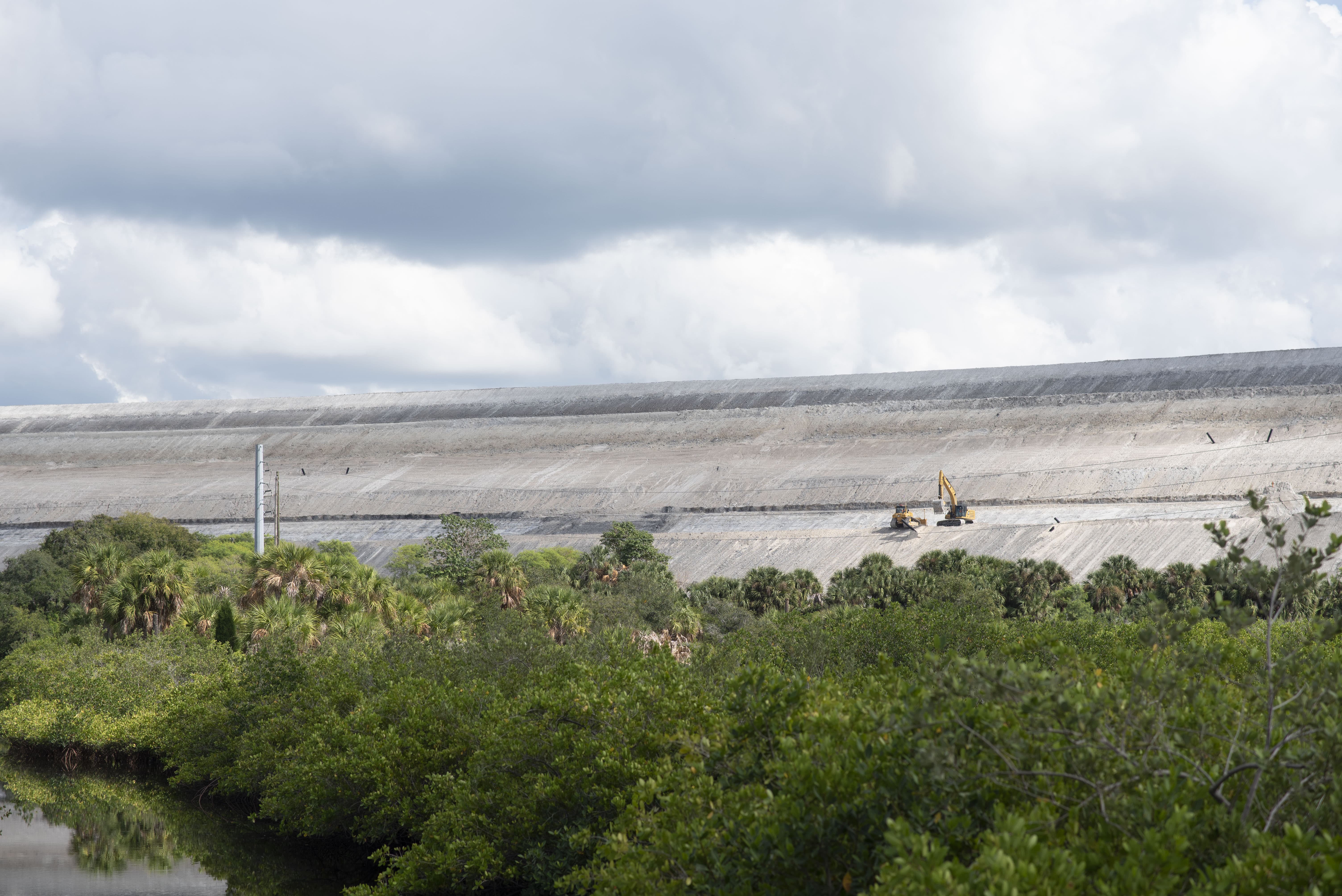
In a “gypstack” near Fort Meade, Florida, processed phosphate rock is piled up and stored indefinitely
Boyce Upholt
Gail LeBeouf grew up near the St. James Parish Mosaic facility—known as the “Uncle Sam” plant, after the plantation that once stood here—and remembers riding her bicycle through fields that are now covered in chalky waste. I met LeBeouf in late October, when she and a dozen other protestors gathered on the highway alongside the stack, holding picket signs and singing gospel songs. They had altered the lyrics: “I told Mosaic to get thee behind,” they sang—a line that typically references Satan.
The Coalition Against Death Alley, a collection of grassroots groups, had organized this protest, one in a series of press conferences along a notorious stretch of the Mississippi River, where the residents, largely Black and often impoverished, have become surrounded by petrochemical plants. LeBeouf, at the protest, spoke about the many residents who are hemmed in by these plants and all their emissions. Now, they live in fear of an additional threat: The facility’s walls could burst, and toxic water could pour into their backyards. As she spoke, she closed her eyes, naming the various companies that owned the Uncle Sam facility before Mosaic bought it in 2004. “This is fifty years of disaster in the making,” she said.
If the water busts loose, it will not be the first time. The region’s 25 gypstacks—which together hold more than a billion tons of phosphogypsum—have failed again and again, sometimes in spectacular fashion. In 1994, a sinkhole opened beneath a stack near Mulberry, sending its water gushing into the underlying aquifer. In 1997, a gypstack wall crumbled, sending some 50 million gallons of wastewater in the Alfia River and killing scores of fish. In 2004, hurricane winds whipped up waves that smashed through a dike atop a gypstack, releasing 65 million gallons.
The latest trouble came in 2016, another sinkhole opened in Mulberry, draining 215 million gallons. Mosaic did not alert the public for nearly three weeks. The company spent two years—more than 350,000 man-hours—plugging the sinkhole with 20,000 cubic yards of grout, and says its tests have repeatedly showed no negative impacts off the site.
The EPA, along with the Louisiana and Florida state departments of environmental quality, sued Mosaic in 2015, alleging that waste materials had been illegally commingled at six plants across the two states, including the Uncle Sam plant. The company settled days later, entering into a consent decree: they would submit to stricter oversights and, among other changes, install new protective engineering around their gypstacks. According to the EPA, the case addressed 60 billion pounds of hazardous waste, the largest amount ever covered by such a settlement.
Within the industry, there is a standard talking point: there is no way to feed the world without mining this rock.
After discovering the movement of Stack No. 4, in early 2019, Mosaic alerted officials, and then began to pump water out of the pond. Managing water is a juggling act; the campus often holds more than a billion gallons in total, spread across various cells and reservoirs, which grow and shrink thanks to rain and evaporation and pumping. Quickly, the company began to dig a new pond. By May, Mosaic asked for permission to use aerators that would spray droplets of wastewater into the air, speeding up evaporation by increasing surface area. The Louisiana Department of Environmental Quality—which confirmed some facts for this story but otherwise declined to comment—denied this request, though in September the company submitted a revised application for the required permits. Then, in December, Mosaic asked for permission to treat the water and dump it directly into the Mississippi. Both applications are still pending, according to the company.
Mosaic says the company had made “significant progress” on the issues facing the gypstack. “Lateral movement of the north slope of the gypstack continues to slow, and there has been no offsite impact, nor is any expected,” Callie Neslund, a public-affairs official, wrote in an email. “The safety of our community, employees and the environment remains our focus.”
—
Once the finished fertilizer leaves a processing plant, it enters the supply chain, where it travels from warehouse to farm store to field. Some of this phosphorus is absorbed by plants, which are then absorbed by animals, including humans—and thus the rocks of the earth become a part of our corporal selves. (One study estimates that people who eat meat also, in this way, eat some 25 pounds of rock a year.) Farmers have other options for phosphorus fertilizer—manure and guano and bone meal, even human urine. But phosphate rock is so ubiquitous that organic farms use it in unprocessed form, too. Within the industry, there is a standard talking point: there is no way to feed the world without mining this rock.
U.S. farmers dump more than four million tons of phosphorus onto their fields each year, far more than plants successfully absorb. By some estimates as much as 40 percent washes into rivers and lakes and oceans, where it can feed massive algal growths. These, too, can have dire consequences: this summer, every beach in Mississippi was closed for days or weeks due to the presence of cyanobacteria. In 2014, an algal bloom on Lake Erie turned the tap water in Toledo, Ohio, undrinkable. This is one more geography of phosphorus, dispersed across the nation, though its extent is hard to map. We know the problem has affected waterways in every state, and costs us billions of dollars each year. Because warmer temperatures promote algal growth, the situation may worsen as the climate warms.
“We just dig stuff up and make stuff with it and then get rid of it, forget about it. And, you know, what’s dawning on us is that there’s no ‘away’ anymore.”
Even if fertilizer use declines, algal blooms will persist for years. James Elser, the co-founder of the Sustainable Phosphorus Initiative at Arizona State University, indicates that the majority of the phosphorus entering Lake Erie was sprayed years ago, but lingers in the soil that gradually washes into local rivers. “It takes a long time to work its way through the system,” he says.
A narrow focus on agriculture is not enough, according to Elser. We need to redesign the entire food system. “It’s sort of symptomatic of the way our capitalistic enterprise has run for, you know, the last several centuries,” he says. “We just dig stuff up and make stuff with it and then get rid of it, forget about it. And, you know, what’s dawning on us is that there’s no ‘away’ anymore.”
During the October march, earthmovers scurried back and forth behind the protesters’ press conference, digging out a new pond at the foot of Stack No. 4—one more place to store the water. Due to oversupplies of fertilizer on the U.S. market, the plant had entered a temporary shutdown at the beginning of the month, which lasted through early December. Through that period, Mosaic kept 120 employees on site to keep the plant functional, including tending to the gypstack: planting survey stakes and reading gauges and overseeing the constant shuttling of water between various holding cells and moving gypsum to build a new dike on a freshly dug pond.
The EPA is already thinking about the day when this and other Mosaic plants shutter completely. Per the terms of the consent decree, Mosaic placed $630 million into a trust fund. The aim is to grow that fund to $1.8 billion, the estimated cost of safely closing down six plants, including Uncle Sam.
—
Mosaic declined my request for a tour of the site. So instead I traveled three hours east, to Pascagoula, Mississippi. The Mississippi Phosphates Corporation was headquartered here until it went bankrupt in 2014. That left behind two gypstacks, along with 700 million gallons of wastewater. An open wound, still festering: every inch of rainfall generates another 9 million gallons of tainted water on the site.
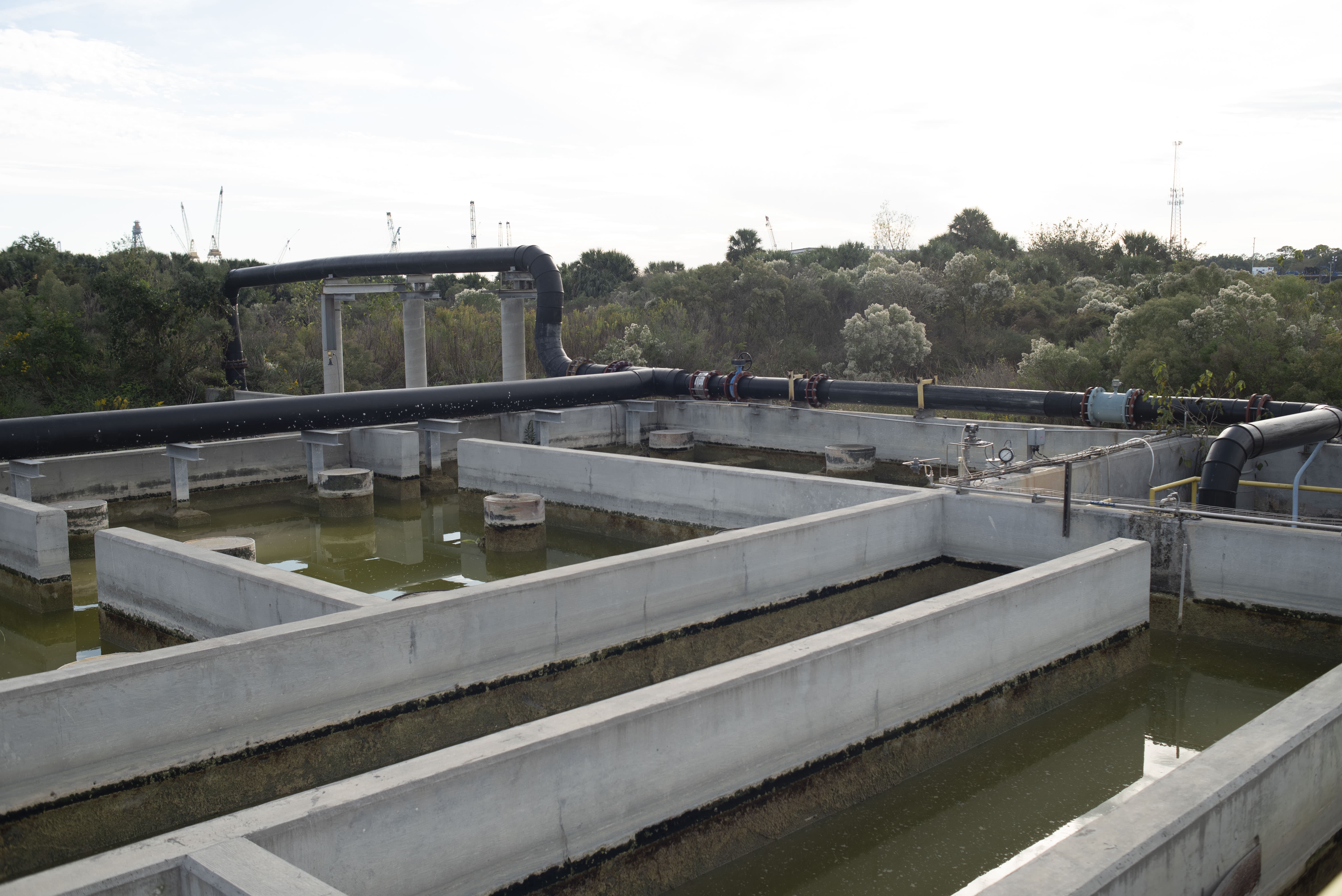
Water acidification cells at the abandoned Mississippi Phosphates Corporation plant
Boyce Upholt
As a part of the bankruptcy proceedings, an environmental trust, valued at $12 million, was launched to fund the stacks’ ongoing care, to be coordinated by the Mississippi Department of Environmental Quality. After just over two years, the money ran out. The EPA declared the old plant a Superfund site and took over cleanup. In 2017, as a tropical storm barreled towards the gypstacks, the agency was forced to make an emergency “bypass”: partially treated wastewater was dumped into the local waterways to ensure the ponds would not overflow. In total, five emergency bypasses were required throughout the year, which put 400 million gallons of the water into a nearby bayou.
Jon Bornholm, a remedial project manager with the EPA, drove me past empty warehouses and rusted pipelines to the wastewater treatment plant on the site, which looked like an outdoor, oversized boiler room, its tankards and towers all caked in a layer of white lime. “The burn rate is about a million,” Bornholm said. In other words, that’s how much the agency spends each month running this system, so they can process two million gallons of wastewater each day, removing phosphorus and nitrogen to prevent the formation of algal blooms. (This process creates even more waste: the spent lime is injected into massive plastic bags, which are laid into nearby pits.) The EPA has also contracted with a company to monitor the presence of radionuclides in the water, but was unable to provide this data.
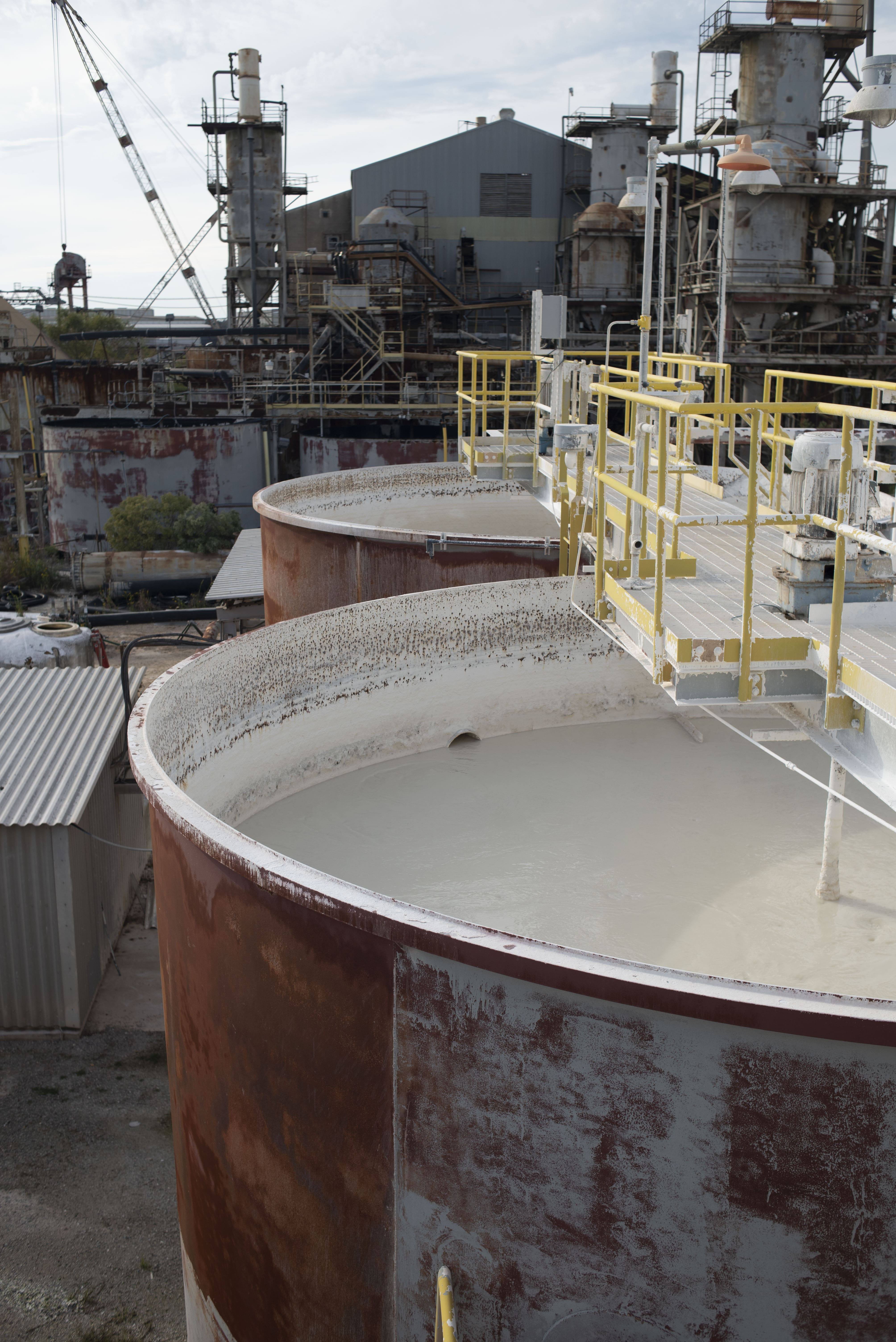
Boyce Upholt
Wastewater treatment infrastructure at the abandoned Mississippi Phosphates Corporation plant
Another firm has been contracted to roll out long sheets of plastic atop of the eastern gypstack, forming a protective layer intended to stop the creation of new wastewater. This process will cost more than $70 million and should be completed in 2020. Though even then the work will not be over: the plastic will be buried beneath sand, which must be replaced every decade. A second gypstack, meanwhile, was covered with a layer of sod in the 1970s, which slows but does not stop its absorption of rainfall. Water sinks through the sod and into the phosphogypsum below, and eventually leaches into moats that surround this stack. Pumps then send this water to the wastewater plant, which will need to run forever, or at least as long as we’re around to pay the bills, or care about keeping the water here clean.
Bornholm drove me to the top of the eastern gypstack, where we watched as a half-dozen workers in hard hats weld together the plastic sheets. The air had a mild odor, a slight sharpness, and the dusty white soil—etched with grooves where water had run down the slope—had the character of a distant planet. Eighty feet above the ground, I could see west to industrial Pascagoula, a tangle of barbed wire and pipelines and glittering exhaust towers, and east to the green lines of a wild estuary, draining the region’s farms into the sea. The stack rose, monumental, between the two, dotted by a fleet of backhoes and excavators. Pushing and dredging and dumping and digging, they rearranged the fine white powder, keeping it all in place.





